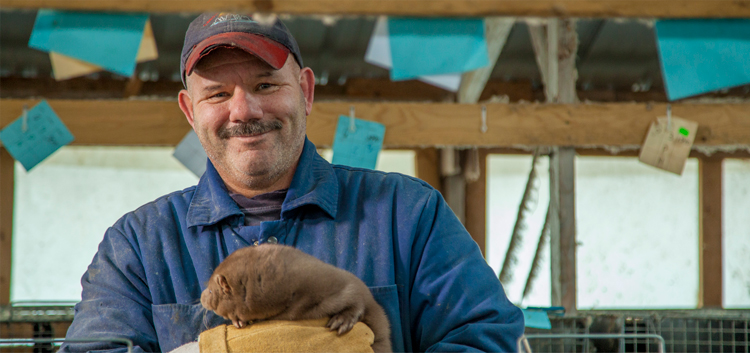
Fur farming is humane
FARMED FUR ANIMALS RECEIVE EXCELLENT CARE
North America produces the finest quality farmed furs in the world. To achieve this, farmers must provide excellent nutrition and care for their animals. National codes of practice and certification programs provide assurance that farmed furbearing animals receive excellent care.The standards of care for farmed mink and fox are based on many years of scientific research.
- United States: to learn more about industry regulations and humane care certification in the US mink industry, visit Fur Commission USA.
- Canada: learn more about animal welfare and stewardship in the Canadian mink industry, as well as the Code of Practice for the Care and Handling of Farmed Mink (also for farmed fox) developed by animal scientists, veterinarians, producers and animal-welfare authorities, under the auspices of the National Farm Animal Care Council (NFACC).
FREEDOM TO EXPRESS NATURAL BEHAVIORS
While raised in pens, farmed furbearers have considerable opportunity to express natural behaviors.
For example:
- Wild mink often travel long distances in nature, but they do so in search of food. Once they have eaten, they spend most of their time (70-80%) in small, underground dens where they feel secure. Farmed mink spend a similar percentage of their time in their nest boxes, going into the attached, larger pens to eat, drink, exercise and play with balls or other objects (“pen enhancements”) that may be available.
- Unlike many of our food animals, farmed mink still couple naturally; females are brought to the males’ pens at breeding time.
- Farmed mink also nurse and raise their own young in their nest boxes until they are weaned.
In contrast with their wild cousins, farmed mink, fox and chinchilla enjoy constant access to nutritious food and clean water, protection from predators and extreme weather, and veterinary care when needed.
MINK AND FOX ADAPT WELL TO LIFE ON THE FARM
Mink are generally solitary in nature. For this reason, farmed mink are housed in individual pens after weaning, or sometimes two siblings to a pen (often a brother and sister). Each pen also includes a snug, enclosed nest box, mimicking the underground dens where wild mink typically spend most of their time when they are not hunting for food.
In the pioneering days of fur farming, both mink and fox were originally raised in “natural” enclosures, on the ground, but this exposed them to parasites and disease. Today, raised, wire-mesh pens allow manure to fall away, keeping the mink clean while protecting them from parasites and disease. Barns and perimeter fences also help to prevent the introduction of diseases that could be transmitted by wildlife.
Farmed mink and fox are both much more docile than their wild cousins. In a famous experiment, Russian geneticist Dmitry Konstantinovich Belyaev demonstrated that tame foxes showing little fear of – and even affection for – their human handlers could be bred in as few as ten generations.
[Trut, Lyudmila N. (1999). “Early canid domestication: The farm-fox experiment” (PDF). American Scientist 87: 160–169. doi:10.1511/1999.20.813.]
BIOSECURITY
In order to protect livestock from disease or infection that might be introduced from wild animals – or from other farms – most North American mink and fox farms enforce strict biosecurity protocols. The tires of vehicles (e.g., trucks delivering feed) are disinfected as they pass through an antiseptic bath before entering the farm yard. Visitors are asked to don disposable jumpsuits and boot covers. Much like in other animal agriculture, biosecurity measures like these are important to ensure that farmed mink and fox remain healthy.
EUTHANASIA: HOW ARE FARMED MINK AND FOX KILLED?
The word “euthanasia” comes from the Greek words eu, meaning “good” or “well”, and thanatos, or “death”. While most farmed animals must eventually be killed, it is our responsibility to ensure that this is done humanely, with as little stress as possible to the animals.
Farmed mink are generally euthanized with bottled carbon monoxide gas. In the late fall when the fur is prime, a mobile unit is brought into the barn and wheeled from pen to pen, minimizing the stress of handling. The mink are placed into an air-tight, gas-filled container where they are rendered unconscious and die quickly and humanely.
Farmed fox are generally euthanized using a specially-designed unit that produces an electrical current to quickly stun and kill the animals. This is the same method that is used to stun pigs and poultry in abattoirs.
From an animal-welfare perspective, it is important that fur animals can be euthanized in their barns by people that feed and care for them daily. Food animals, by contrast, must be loaded onto trucks and transported to distant abattoirs to assure hygiene and human health. Loading, unloading and transportation in close confines with many other animals is generally much more stressful for animals than the actual slaughtering operation.






